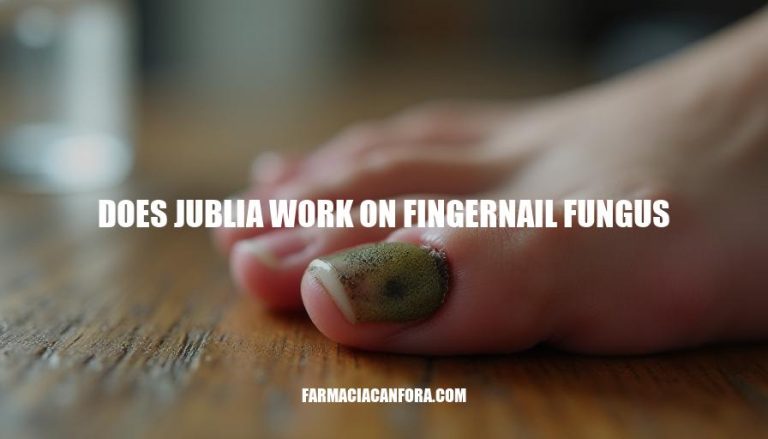


Jublia (efinaconazole) is a topical antifungal medication primarily used to treat toenail fungus (onychomycosis). It works by inhibiting the growth of fungi, making it effective for many users. While Jublia is FDA-approved for toenail fungus, its effectiveness on fingernail fungus is less documented. However, it may still be prescribed off-label for fingernail infections. Always consult a healthcare provider for personalized advice.
Jublia (efinaconazole) is an azole antifungal used to treat onychomycosis (fungal infection of the nails). It works by inhibiting an enzyme essential for the fungus to build its cell wall, weakening the fungus and preventing its growth.
Application Method:
Jublia (efinaconazole) has been evaluated in multiple clinical studies for its effectiveness in treating onychomycosis (fungal infection of the nails). Here are the key findings:
FDA Approval: Jublia was approved based on two Phase 3 clinical trials involving 1,651 patients with toenail fungal infections. Participants applied Jublia daily for 48 weeks.
Efficacy Results: In these trials, Jublia showed a complete cure rate (0% clinical involvement of the target toenail) of 15-18% compared to 3-5.5% for the placebo. Mycologic cure rates (negative fungal culture) were 53-55% for Jublia versus 16-17% for the placebo.
Safety Profile: Common side effects included ingrown toenail, itching, inflammation, rash, and pain. No significant differences in side effects were observed across different age groups.
Comparative Studies: Jublia has been shown to outperform other topical treatments like ciclopirox and tavaborole in terms of fungal clearance and symptom resolution.
Patient Demographics: The studies included a diverse group of participants, with a trend towards greater efficacy observed in women and Asians.
These studies collectively support Jublia’s effectiveness in treating nail fungus, particularly for mild to moderate cases.
User reviews for Jublia (efinaconazole) for treating fingernail fungus are mixed. Some users report positive outcomes, noting significant improvement in nail appearance and effectiveness when used consistently over several months. However, others express dissatisfaction, citing high costs and lack of noticeable results even after prolonged use. Common feedback includes the necessity of daily application and patience due to the slow nature of nail growth.
Here are the potential side effects of using Jublia (efinaconazole) for fingernail fungus:
Jublia (efinaconazole) is an FDA-approved topical antifungal medication primarily used to treat toenail fungus. While its effectiveness on fingernail fungus is less documented, it may still be prescribed off-label for fingernail infections.
User reviews are mixed, with some users reporting positive outcomes and others expressing dissatisfaction due to high costs and lack of noticeable results.
Common side effects include:
Clinical studies have shown Jublia’s effectiveness in treating onychomycosis, particularly for mild to moderate cases, with a complete cure rate of 15-18% compared to 3-5.5% for the placebo.
However, its efficacy on fingernail fungus is not as well-documented and may require off-label use.